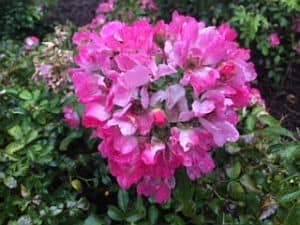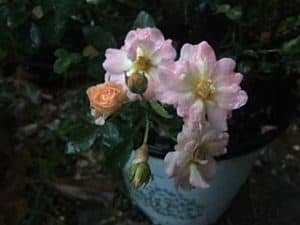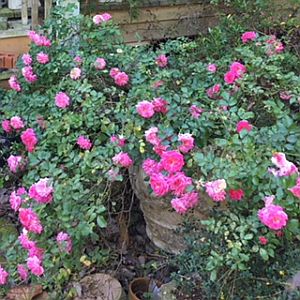
Landscape Roses/Drift Roses
Considered the queen of flowers, roses are a tradition in New Orleans. Roses have been grown in our area as far back as 1731 by the Ursulines. Most of these roses were called old roses or garden roses. The Cherokee rose was one of several roses grown back in the late 18th century and is now naturalized in Louisiana. You can see Cherokees climbing along the road sides on the Northshore with single white flowers growing along thick thorny stems. While I love the old roses, landscape roses are an up and coming class of roses led by the drift roses which offer almost everblooming quality.
Drift series of low-maintenance roses, are from Conard-Pyle/Star Roses, the same breeders who gave us the Knock Out series of low-maintenance landscape roses. Drift roses are considered landscape roses and are a cross between full-size ground-cover roses and miniature roses at about 2’x 3′. The low, spreading habit of Drift roses makes them perfect for small gardens, combination planters, single specimen containers, low hedges and as a groundcover for the landscape.

Drift roses come in pink, coral, red, peach, apricot (double blooms), sweet pink (clearer pink double blooms) and popcorn (whitish yellow). All of these bloom from spring to early frost. The foliage on Drift roses is smaller than other shrub roses and is a dark green. All colors in the Drift series of roses have been designated Louisiana Super Plant selections.
According to the Hammond Research Center, Drift roses have about five flower cycles a year. The spring bloom in April and the fall bloom in October, as with most other roses, are the peak times for best performance. The late-spring-to-early-summer second bloom is also impressive.
Plant in a well-prepared raised bed using plenty of organic matter, and space individual plants a minimum of 3 feet apart. It would be best to plant them 4-5 feet apart if you are thinking long term. The soil pH for roses needs to be between 6.0-6.5. As with almost all roses, Drift roses need 6- 8 hours of full sun. Drift can be planted anytime of the year. In my opinion, Fall is the best time to plant roses. They establish better in the cooler weather and provide color for the fall garden.
After planting in the fall, fertilize Drift roses in the spring with a slow-release or timed fertilizer – which releases nutrients to the plant when it needs it most. Fertilize again in late summer to help plants bloom better into fall, especially in new landscape beds where nutrients may be lacking. Mulch roses to keep roots from drying out and to control weeds.
Drift roses are truly low-maintenance roses are highly disease resistant. They require no spraying. Blackspot disease has been very minimal on plants grown in Louisiana. Typical bugs and caterpillars will munch on them from time to time but cause no harm. Bed preparation, irrigation and proper fertilization management are the keys to success.
Drift roses combine wonderfully with flowering perennials, ornamental grasses and more. Drift rose look stunning in the front of a garden bed and keep the color going even during the hot months.
Submitted by Karen Blackburn




